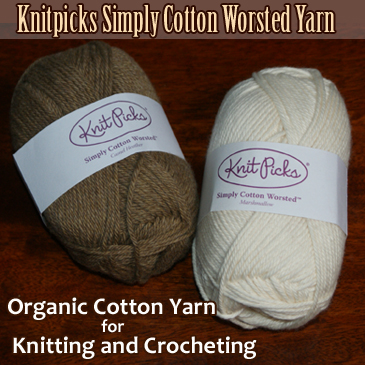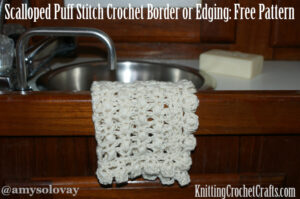Learn How to Crochet a Dishcloth or Washcloth With These Free Step-By-Step Instructions.
It’s easy to crochet a dishcloth or washcloth; these utilitarian kitchen items make some of the best crochet patterns for beginners because they do not have to fit anybody, and matching someone else’s gauge isn’t usually that important when you crochet a dishcloth or washcloth. Those are a couple of the biggest pitfalls beginners run into when learning how to crochet. Beyond that, they also make fun and interesting projects for more experienced crocheters.
Dishcloths and washcloths are both fun projects to crochet. They offer a fantastic opportunity to try out different crochet stitches and color combinations. They don’t involve any significant investment of either time or money; they work up quickly, and when you’re finished you have a useful item that you can give away or keep. It’s fun to include them in special kitchen-themed or spa-themed gift baskets for Mother’s Day, birthdays, Christmas or other holidays and gift-giving occasions.
If you want to crochet a dishcloth, here are the basic instructions to follow; or you can scroll down if you’d prefer to look through some ready-made crochet dishcloth patterns; I’ve linked to bunches of free crochet dishcloth patterns, plus there is a crochet ripple class I recommend that also includes a really lovely dishcloth pattern.
Step-By-Step Instructions for How to Crochet a Dishcloth or Washcloth
1. Choose a Pattern
Chose either a dishcloth pattern or a stitch pattern to use. Whichever you prefer, we’ve got you covered with plenty of free patterns to choose from:
If you’d like your cloth to be mildly abrasive, you can choose a bumpy-textured crochet stitch; a good example is this puff lace crochet washcloth pattern. If you want your washcloth to be super soft, choose a simple crochet stitch that doesn’t have much texture.
2. Choose Yarn

The next step is choosing one or more yarns to use. I recommend using an organic cotton yarn for crocheting dishcloths and washcloths. It is also possible to achieve acceptable results using microfiber yarn, but I hesitate to recommend microfiber due to environmental concerns.
If this is your first dishcloth or washcloth project, I recommend choosing one yarn and making a solid-colored dishcloth or washcloth; I make this recommendation because it is easier to crochet with a single color than it is to hassle with color changes and weaving in more ends than you have to. But, that’s up to you; you can use as many yarn colors as you like in your project.
Please keep in mind that you do have the option to use variegated yarn, which is the term used when a yarn is dyed into more than one color. This is a good option to try if you want a multicolored dishcloth or washcloth, but you don’t want to mess around with changing colors or weaving in lots of ends in your finished project.
For dishcloths, most crocheters use kitchen cotton yarn, although there are other possibilities. Currently, Simply Cotton Worsted, Sport and Fingering weight yarns by Knitpicks are my favorite yarns for crocheting dishcloths and washcloths. I’ve also seen crocheters use cotton embroidery floss, mercerized cotton yarns, and cotton crochet threads to make dishcloths. The key: choose an absorbent material that can be machine washed and will stand up to significant wear and tear.
These same criteria also apply to washcloths, but for a washcloth you have one additional consideration. The material you choose should also be soft enough for prolonged use on human skin. Kitchen cotton is adequate, but you might prefer to choose an even softer yarn. I find that Simply Cotton Worsted yarn is soft enough to make a lovely washcloth, yet strong enough to withstand the frequent washing that a washcloth is typically subjected to. Any washable, soft, long-stapled cotton yarn could make a nice washcloth.
3. Choose a Crochet Hook
In many cases, you’ll be able to use the crochet hook size suggested on the yarn label or your pattern. When crocheting dishcloths or washcloths with worsted weight kitchen cotton yarn, I usually use a 5.00 mm crochet hook, which is a US size H. You might be more comfortable using a G or I or J hook, depending on how you crochet and the pattern you choose.
4. Calculate the Number of Chain Stitches in Your Starting Chain
If you’re going to use a dishcloth or washcloth pattern, your pattern will tell you everything you need to know from here on out, including the length of your starting chain. So if you’ve selected a pattern, just check your pattern and follow it from start to finish to complete your project.
If you decided to use a stitch pattern, you’ll need to figure out how long you want to make your starting chain. You will need to calculate the number of chain stitches to work for your starting chain by checking your stitch pattern for the phrase “multiple of _______ + _______”. It will usually say something like “this pattern is a multiple of 3 + 2 stitches”. The first number tells you the number of stitches needed for each design repeat; the second number tells you how many extra chains you will need to include to make the math work out right when you include the first turning chain and additional stitches that might be needed to make the design turn out satisfactory.
If you want a six-inch dishcloth, you’ll need to figure out how long one stitch repeat is and then do the math to determine how many repeats you need to crochet all together to have your dishcloth turn out to be six inches wide.
5. Crochet the Dishcloth or Washcloth
The next step is to crochet your dishcloth, working in the stitch pattern you’ve chosen.
6. Weave in Your Loose Ends
When you’re finished, weave in your ends. You will have at least 2 loose ends; one at the beginning of your dishcloth / washcloth, and another at the end. You might have additional loose ends in between depending on whether you needed to change colors or start a new ball of yarn midway through the project.
7. Wash Your Dishcloth or Washcloth Before Using It or Giving It As a Gift
It is not essential to wash your dishcloth or washcloth before using it, but you may wish to do so. This will remove any excess dyes or chemicals that are present in the yarn.
So there you have it: That’s how to crochet a dishcloth, step by step. We hope you found this free crochet tutorial helpful. If you have any questions, feel free to post a comment; we’ll try our best to help if we are able.
Free Crochet Dishcloth and Washcloth Patterns
Puff Stitch Lace Crochet Dishcloth or Washcloth: Free Pattern

Click or tap here to find more kitchen craft project ideas and instructions.
Related Resources:
- The Best Crochet Books for Beginners
- Beginner Crochet
- Basic Crochet Stitches
- Crochet Patterns for Total Beginners
Posted By: Amy Solovay
This page was last updated on 5-5-2023.